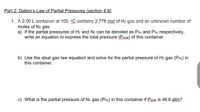
Chemistry
10th Edition
ISBN: 9781305957404
Author: Steven S. Zumdahl, Susan A. Zumdahl, Donald J. DeCoste
Publisher: Cengage Learning
expand_more
expand_more
format_list_bulleted
Concept explainers
Question

Transcribed Image Text:Part 2: Dalton's Law of Partial Pressures (section 8.8)
1. A 2.00 L container at 100. C contains 2.778 mol of H2 gas and an unknown number of
moles of N2 gas.
a) If the partial pressures of H2 and N2 can be denoted as PH2 and PN2 respectively,
write an equation to express the total pressure (Psotal) of this container.
b) Use the ideal gas law equation and solve for the partial pressure of Hz gas (PH2) in
this container.
c) What is the partial pressure of N2 gas (PN2) in this container if Pseral is 46.6 atm?
Expert Solution
This question has been solved!
Explore an expertly crafted, step-by-step solution for a thorough understanding of key concepts.
This is a popular solution
Trending nowThis is a popular solution!
Step by stepSolved in 2 steps with 2 images

Knowledge Booster
Learn more about
Need a deep-dive on the concept behind this application? Look no further. Learn more about this topic, chemistry and related others by exploring similar questions and additional content below.Similar questions
- At 750 K, a 296 mL container of Xe at 3.02 atm is connected by a valve to a 441 mL container of H2 at 2.68 atm. What is the total pressure, in atm, in the container after the valve is opened? volume: mol Xe: mol H2: mol fraction Xe: mol fraction H2: partial pressure Xe: partial pressure H2:arrow_forwardIf a gas sample (containing only N2 and O2) has a partial pressure of N2 of 360 mmHg and a partial pressure of O2 of 225 mmHg, what is the mole fraction of N2 in the sample?arrow_forwardA sample of an ideal gas with an initial volume of 18.0 L at a pressure of 679 mm Hg is compressed until the volume is 3.4 L with no change of temperature. What is the final pressure (mm Hg) of the gas?arrow_forward
- 16. The surface temperature of Venus is about 1050 K, and the pressure is about 75.0 earth atmospheres. Assuming that these conditions represent a Venusian "STP", what is the "standard" molar volume of a gas on Venus? 17. Gaseous iodine IFs can be prepared by the reaction of solid iodine and gaseous fluorine: k (s) + 5 F2 (g) → 2 IFs (g) A 5.00-L flask is charged with 10.0 g of k and 10.0 g of F2, and the reaction proceeds until one of the reagents is completely consumed. After the reaction is complete the temperature in the flask is 125°C. What is the partial pressure of IFs in the flask? 6.arrow_forwardWhat is the partial pressure of N₂O in a gas mixture of 15.4 g of N₂O and 6.36 g of SO₂ at a total pressure of 7.91 atm? The molar mass of N₂O is 60.02 g/mol, and the molar mass of SO2 is 64.07 g/mol. Do not put units in your answer. Record your answer to 2 decimal places.arrow_forwardA mixture of hydrogen and carbon dioxide gases contains hydrogen at a partial pressure of 619 mm Hg and carbon dioxide at a partial pressure of 179 mm Hg. What is the mole fraction of each gas in the mixture? X. = H₂ хсог =arrow_forward
- 1. A 2.00 L container at 100. oC contains some H2 gas and some N2 gas. a) If the partial pressures of H2 and N2 can be denoted as PH2 and PN2 respectively, write an equation to express the total pressure (Prota) of this container. (The container only has H2 gas and N2 gas) b) What is the partial pressure of N2 gas (PN2) in this container if Piotal is 46.6 atm and the partial pressure of H2 gas is 42.4 atm?arrow_forwardthe answer for part a was 11.73. please show work for part b and explain c, thanks Calculate the pressure exerted by 17 grams of Cl2 in a 1.00 L container at 25.0 °C Report in the unit of atmospheres a. Using the ideal gas law b. Using the van der Waals equation. (Van der Waal's constants for Cl2 are a= 6.49 and b = 0.0562) c. Compare the results. (Explain on a molecular level)arrow_forwardGaseous ammonia is synthesized from nitrogen and hydrogen by the reaction N2(g) + 3H2(g)→ 2NH3(g) Assume you take 355 L of H2 gas at 25.0 °C and 542 mm Hg and combine it with excess N2 gas. a )What is the theoretical yield of NH3 gas? b) If this amount of NH3 gas occupies a 125-L tank at 25.0 °C, what is its pressure?arrow_forward
arrow_back_ios
arrow_forward_ios
Recommended textbooks for you
 ChemistryChemistryISBN:9781305957404Author:Steven S. Zumdahl, Susan A. Zumdahl, Donald J. DeCostePublisher:Cengage Learning
ChemistryChemistryISBN:9781305957404Author:Steven S. Zumdahl, Susan A. Zumdahl, Donald J. DeCostePublisher:Cengage Learning ChemistryChemistryISBN:9781259911156Author:Raymond Chang Dr., Jason Overby ProfessorPublisher:McGraw-Hill Education
ChemistryChemistryISBN:9781259911156Author:Raymond Chang Dr., Jason Overby ProfessorPublisher:McGraw-Hill Education Principles of Instrumental AnalysisChemistryISBN:9781305577213Author:Douglas A. Skoog, F. James Holler, Stanley R. CrouchPublisher:Cengage Learning
Principles of Instrumental AnalysisChemistryISBN:9781305577213Author:Douglas A. Skoog, F. James Holler, Stanley R. CrouchPublisher:Cengage Learning Organic ChemistryChemistryISBN:9780078021558Author:Janice Gorzynski Smith Dr.Publisher:McGraw-Hill Education
Organic ChemistryChemistryISBN:9780078021558Author:Janice Gorzynski Smith Dr.Publisher:McGraw-Hill Education Chemistry: Principles and ReactionsChemistryISBN:9781305079373Author:William L. Masterton, Cecile N. HurleyPublisher:Cengage Learning
Chemistry: Principles and ReactionsChemistryISBN:9781305079373Author:William L. Masterton, Cecile N. HurleyPublisher:Cengage Learning Elementary Principles of Chemical Processes, Bind...ChemistryISBN:9781118431221Author:Richard M. Felder, Ronald W. Rousseau, Lisa G. BullardPublisher:WILEY
Elementary Principles of Chemical Processes, Bind...ChemistryISBN:9781118431221Author:Richard M. Felder, Ronald W. Rousseau, Lisa G. BullardPublisher:WILEY

Chemistry
Chemistry
ISBN:9781305957404
Author:Steven S. Zumdahl, Susan A. Zumdahl, Donald J. DeCoste
Publisher:Cengage Learning

Chemistry
Chemistry
ISBN:9781259911156
Author:Raymond Chang Dr., Jason Overby Professor
Publisher:McGraw-Hill Education

Principles of Instrumental Analysis
Chemistry
ISBN:9781305577213
Author:Douglas A. Skoog, F. James Holler, Stanley R. Crouch
Publisher:Cengage Learning

Organic Chemistry
Chemistry
ISBN:9780078021558
Author:Janice Gorzynski Smith Dr.
Publisher:McGraw-Hill Education

Chemistry: Principles and Reactions
Chemistry
ISBN:9781305079373
Author:William L. Masterton, Cecile N. Hurley
Publisher:Cengage Learning

Elementary Principles of Chemical Processes, Bind...
Chemistry
ISBN:9781118431221
Author:Richard M. Felder, Ronald W. Rousseau, Lisa G. Bullard
Publisher:WILEY